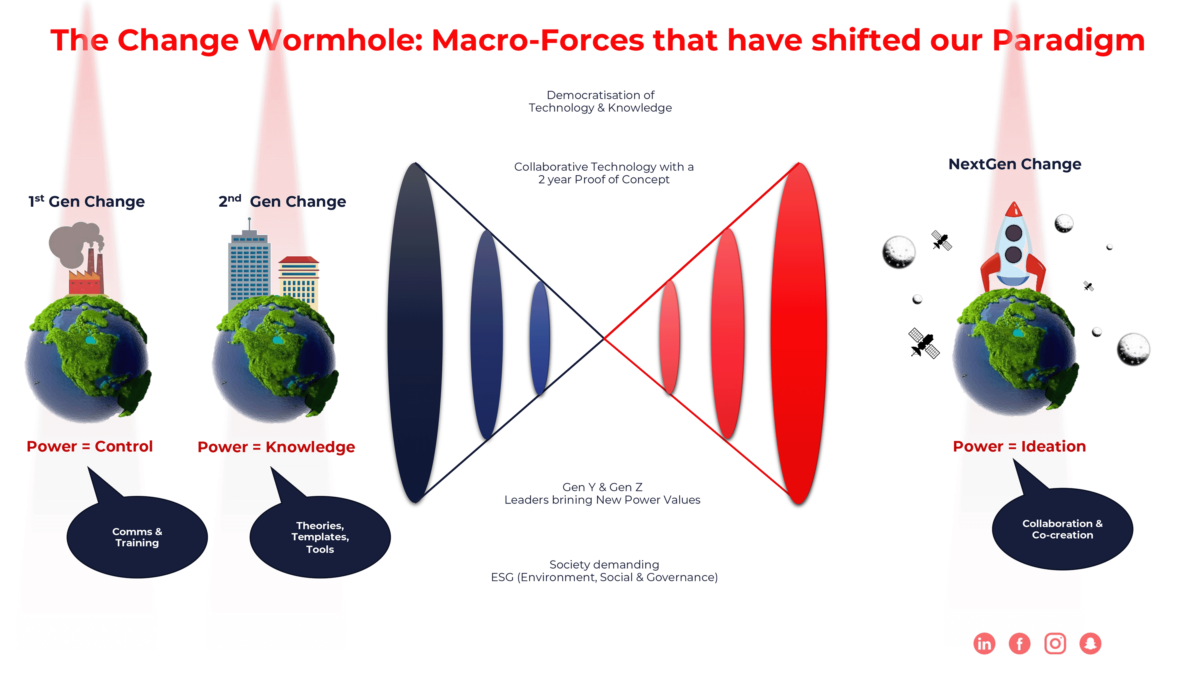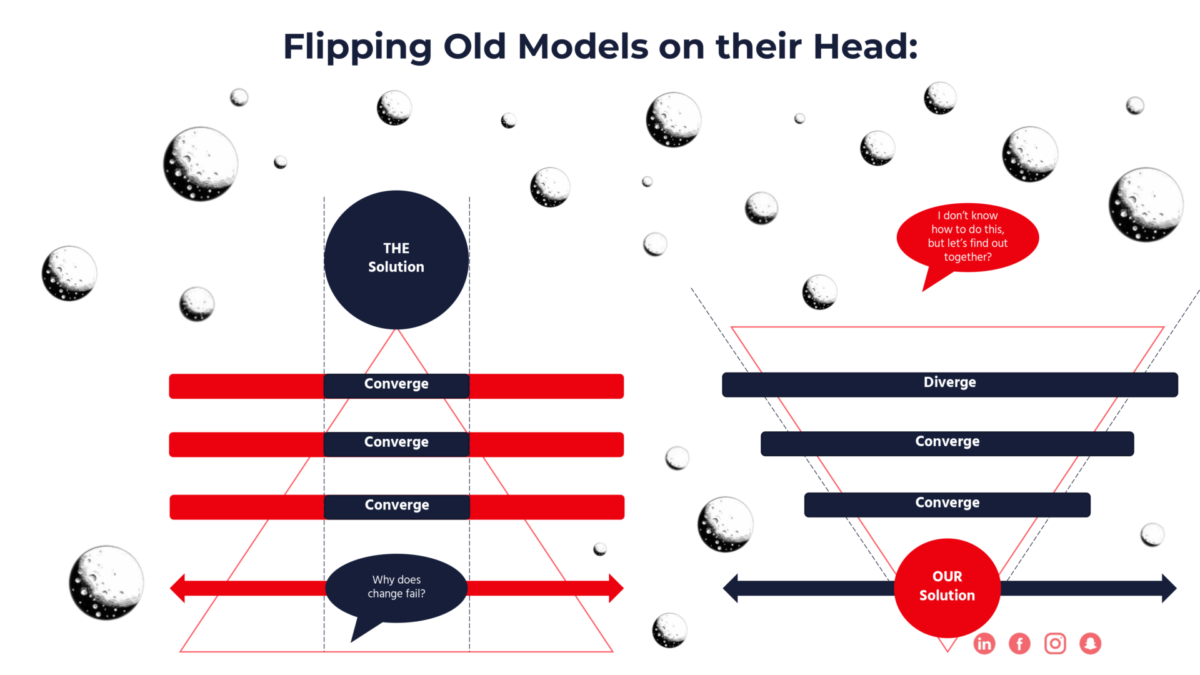By Andrew Butow – Earth2Mars
Reflecting on the past few years leaves me awestruck; baffled with a bizarre mixture of nervousness and excitement brewing within. It’s as if we found ourselves sucked into a wormhole and come out on a completely different side of the space-time continuum, realising just how much has changed.
And the same can be said about our change industry and how approaches to a new frontier in workforce technology and culture have changed.
The events of the past few years make it seem quick and sudden, yet so many forces have been conspiring, shifting our ways of work forward and into the next generation of what many of us are seeking as meaningful work:

Through affordable and powerful devices and the freedom to access information and each other via the cloud. This has launched the workforce forward, away from the industrial age command and conquer style, against the institutionalised control of knowledge by the powerful few in the information age, towards a new age of open-source models of work where ideas are shared, solutions are co-created and knowledge is easily shared and accessible to all directly through an internet connection.
- 2 years’ worth of global proof of concept of remote and hybrid ways of work:
Thanks to the forced lockdowns of the pandemic, it has made it hard to justify traditional office-based policies and expectations. The workforce has not only had a sizable taste of the power of collaborative technology, but also a long time to reflect on ways of work, individual values and the success of virtual and remote collaboration.
- GenY and GenZ rapidly emerging as leaders:
Either within organisations or separately on their own steam as independent consultants and entrepreneurs in the gig economy. As more from these generations take up positions in leadership, a new value system is challenging what it means to share power and lead change, and a growing voice for insisting on collaboration, crowd-sourced wisdom, sharing and radical transparency.
- Society and consumers demanding a focus on environment, society and governance (ESG):
Thanks to the power of social media and the hyper-connected world we live in, society and consumers alike are holding leaders in both the public and private sectors to account when it comes to the broader impacts of business beyond profit. Leaders and organisations can now be singled out publicly to answer for decisions that negatively impact our planet and society. Just watch the news to see who’s the latest to make the headlines.

As a result of this multi-dimensional shift, leaders are looking to change for answers, and we have seen a huge growth in the demand for change leadership and the value of what we do for people.
No matter where you are in your change career, I think we can all agree that our opportunity is finally here to make sense of a changing work stratosphere and help organisations and executives understand how to truly leverage the human potential right.
This is at the heart of what it means to be NextGen Change. So come with us on an adventure down the wormhole as we share how we have put human potential back into the change equation.
Change – The Next Frontier

Can you recognise this picture? This is humanity’s first-ever picture of a black hole, turning theory into a reality. Now if you are sitting there wondering what on earth a black hole has to do with the complexity and uncertainty we are all facing on transformation projects, take a moment to appreciate this.
‘Black Holes: The Edge of all we Know’ is a great documentary on Netflix that delves into the details and the approach used to co-create the Event Horizon Telescope which, in 2019, gave us the first of many images of a black hole. The best part was they didn’t have to build anything. Instead of the experts taking the lead, Stephen Hawkins and the team had the humility to acknowledge that they didn’t have all the answers. But the solution was literally under their noses – a diverse, global community of space nerds who each have their own telescope and share their passions online.
Leveraging the power of human-centred design and collaborative technology, the team tapped into the collective brain power and potential of this global community and simply put the challenge to the community.
So, if this works for black holes, what can we learn for our projects closer to Earth?
It is this exact approach that we at Earth2Mars have been using for almost a decade, encouraging organisations to flip traditional models of transformation on their heads and co-creating change solutions with all layers exposed to the change challenge, soliciting diverse ideas, and converging around a co-created approach to transformation.
Let’s bring this back to Earth…
If you thought our previous case study was a bit too spacey, how about we turn the lens on some of the real challenges we have seen and how we have practically approached them.

For industrial or information age leaders, we have traditionally followed quite a rigid approach to transformation, projects and change.
In our approach with clients, we have worked with leaders to do a Stephen Hawkins and be okay with not having all the answers in the face of rapid and complex change.
The result of change being done with people instead of it being done to them has achieved remarkable results for the programs of change we run as well as change leaders who have embraced the approach of co-creation and leverage collaborative technology intentionally and cleverly.
At Earth2Mars, we call this Open-Source Change and we have a clear summary of the aggregated ranged results we have seen over the last 8 years of applying (and not applying) this approach.
Busting the Myths of Open-Source Change Approaches
Now I know what you are thinking…How do we shift and enhance existing models of transformation forward, especially with executives who are comfortable with industrial or information age models? Doesn’t consulting all layers of an organisation take more time and diminish the authority of leadership? How do we do this with everything that is going on in the change space?
Myth #1 – Staff consultation takes more time.
Myth #2 – Traditional Change is already human-centric.
Myth #3 – Our organisation is far too old school/conservative for this.
How might we navigate NextGen Change?
With many years of war stories, learning from our missteps, and taking on board ongoing feedback from our course alumni community who apply this in their own work, we have found that by breaking up the challenge into core areas is helpful to get you started on the right foot. Sometimes it’s about “one small step for a (wo)man” that allows for greater leaps going forward.
By taking active steps across all the three following areas we’re able to solve for complex change:
Change Value
We need executives to perceive and believe in the value of people, the value of engaging, collaborating, and asking.
This can be a huge mindset shift, let alone a shift in model for leaders, but the good news is because of the pandemic it’s put HR, learning and development, communication, and particularly change people at the front and centre of the change.
Change Capability
We’re starting to move away from the prescriptive type of change and into a world where really, it’s about human-centred design.
Human-centred design is all about engagement. If you want to drive virtual or face-to-face engagement, we need to be working with the people and co-creating change. This makes change capability a focus on continuous learning.
Change Capacity
You can have the best vision from leaders, the best change capability that’s inclusive, dynamic, uses human-centred design and collaborative technology.
This is why understanding your people’s change capacity is critical.
To leave you with some key takeaways and food for thought:
- It’s time to embrace the next generation of leadership and change.
- Our new north-star in change and leadership is ideation, collaboration, and co-creation.
- Mind the expectation gap between traditional models and leadership styles and the new values and expectations of new power consumers and employees alike.
- Let’s get comfortable with New Power Values applied in the world of work and find new ways to harness this type of engagement
- Human-centred design is a skill that can be learnt.
To learn more about building your NextGen Change skills and future-proof your inner change leader, get in touch with us.
Members please log in to the Member Hub to read the full article and view the full event recording by Andrew Butow of Earth2Mars.




